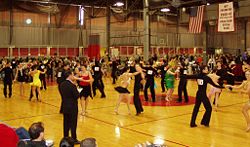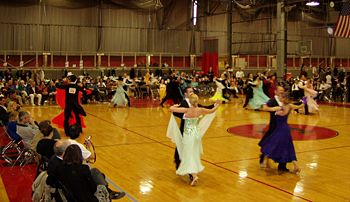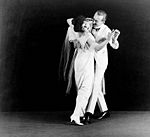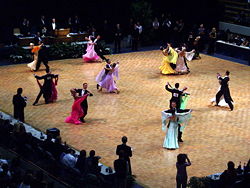Difference between revisions of "Ballroom dance" - New World Encyclopedia
(1st 100) |
|||
| Line 1: | Line 1: | ||
[[Image:MIT 2006 Standard Prechamp Final 2.jpg|thumb|350px|Standard dancing (prechampionship final) at the 2006 MIT Ballroom Dance Competition.]] | [[Image:MIT 2006 Standard Prechamp Final 2.jpg|thumb|350px|Standard dancing (prechampionship final) at the 2006 MIT Ballroom Dance Competition.]] | ||
| − | Ballroom dance refers to a set of learned [[partner dance]]s, which are enjoyed | + | Ballroom dance refers to a set of learned [[partner dance]]s, which are enjoyed [[social dance|socially]] and engaged in [[competitive dance|competitively]] around the globe. While the waltz is credited with having been "invented" in [[Austria]], the foxtrot is a purely American creation, and the [[tango]] is known to have originated in [[Argentina]]. No matter its origins or various adaptations and styles, ballroom dance can be said to enjoy a truly international following. |
In recent years Ballroom Dance has enjoyed a resurgence of popularity, in [[Theater|stage]], [[film]], and on [[television]] | In recent years Ballroom Dance has enjoyed a resurgence of popularity, in [[Theater|stage]], [[film]], and on [[television]] | ||
Revision as of 20:33, 10 January 2009
Ballroom dance refers to a set of learned partner dances, which are enjoyed socially and engaged in competitively around the globe. While the waltz is credited with having been "invented" in Austria, the foxtrot is a purely American creation, and the tango is known to have originated in Argentina. No matter its origins or various adaptations and styles, ballroom dance can be said to enjoy a truly international following.
In recent years Ballroom Dance has enjoyed a resurgence of popularity, in stage, film, and on television as it often does during times of war and economic depression. Its structure, grace, and elegance affords people not only social contact and recreation, but the added benefit of exerise combined with physical expression. Ballroom dance has a broad based appeal that reaches young and old alike making it a popular past time that crosses gender and generational boundaries.
Due to its consideration by the International Olympic Committee, ballroom dancing has received the categorization of DanceSport and will be considered as an additional sport offering for the 2016 Olympics. [1]
Definition and history
The term "ballroom dancing" is derived from the word ball, which in turn originates from the Latin word ballare which means "to dance." The history of ballroom dance dates back to at least the era of court balls lavishly conducted by the Ancien Regime of France under Louis XVI in the 1700s and of the other European aristocracy of Engand, Austria and Russia. In her memoirs, Souvenirs Madame Elisabeth Vigee Le Brun, official portraitist to Marie Antoinette said of dance in her era,...They danced the waltz with such frenzy that I could not imagine how all these people, spinning around at such rate, did not get giddy and fall down; but men and women are so accustomed to this violent exercise that they did not take a single break as long as the ball lasted. They also frequently danced the Polanaise, far less fatiguing, for it is nothing more than a procession during which twosomes promenade in stately fashion. It marvelously suits pretty women as it affords all the necessary time to admire their figures and faces.
While the Puritans who settled in the New World discouraged dance of any kind, ballroom dance still found a welcome reception among colonists. John Adams is said to have dance; George Washington also loved ballroom dance and the first inauguration ball became a precursor for those to follow in the new republic.
Ballroom dance was taught through various schools and was ............
Today, the term applies to any one of the several dances in which two individuals, a "leader" and a "follower," dance with physical contact through their upper or lower bodies, or simply through their arms depending on the particular dance. Since most social dancing is unchoreographed, this contact is necessary for the leader to communicate the next dance move to the follower, and for the follower to respond to this lead. This stands in stark contrast with the style(s) of dance seen in clubs and other social gatherings where physical contact tends to be optional and the individuals in question can move freely without any such restraints imposed by firm physical contact or by the necessity to follow the rhythmic pattern present in the music. Some knowledge of step patterns is essential for both the leader as well as for the follower to be able to effectively practice the art of ballroom dancing.
Dance historians usually mark the appearance of the twist in the early 1960s as the end of social partner dancing. In the modern dance era, dance became free-er and less structured, less dependent on lessons, knowledge and special training. However, during times of economic crisis and war ballroom dance re-captures some of it popularity as it harkens back to a simpler era when dance could be gracious, formal, and shared by all ages, and both sexes alike.
Astaire and Rogers
In the early 20th century, the on-screen dance pairing of Fred Astaire and Ginger Rogers greatly influenced ballroom dancing in the USA. Although both actors had separate projects and careers, they are perhaps most remembered for their dance sequences together, which included numerous movies such as ...................... One of their earlier collaborations involved their portrayal of early 20th century Vernon and Irene Castle, ballroom dance pioneers who early work and life reached iconic status after Vernon's heroics during World War I.
[1] Much of Astaire and Rogers' work portrayed social dancing, although the performances were highly choreographed (often by Astaire or Hermes Pan), and meticulously staged and rehearsed.[2]
Competitive dancing
In spite of its historical image as a pastime for the privileged; formal competitions, sometimes referred to as DanceSport, often allow participation by less advanced dancers at various proficiency levels.
In the United States, amateur dance proficiency levels are defined by USA Dance (formerly United States Amateur Ballroom Dance Association, USABDA) as Bronze->Silver->Gold for syllabus dancers, and Novice->Prechampionship->Championship for open competitors.[3] These levels roughly correspond to the "E" to "S" levels in Europe and Australia. Among professionals, levels classify into Rising Star and Open Professional.
Eligibility and "leveling up" requirements will vary greatly between countries and sometimes within. For instance, in addition to USA Dance competitions, amateur dancers in the United States often participate in competitions sanctioned by NDCA or YCN (Youth Collegiate Network), each with its own distinct culture in addition to differing definitions of level and eligibility requirements.
The International Olympic Committee now recognizes competitive ballroom dance. It now appears doubtful that it will be included in the Olympic Games especially in light of efforts to reduce the number of offerings, but the application has not been permanently rejected.
Ballroom dancing competitions in the former USSR also included the Soviet Ballroom dances, or Soviet Programme. Australian New Vogue is danced both competitively and socially. In competition there are 15 recognised New Vogue dances, which are performed by the competitors in sequence. Internationally, the Blackpool Dance Festival, hosted annually at Blackpool, England, is considered the most prestigious event a dancesport competitor can attend.
Elements of competition

In competition ballroom dancers are judged by diverse criteria such as connection, frame, posture, speed, timing, proper body alignment, proper usage of weight/ankles/feet, and grooming. [4] Judging in a performance-oriented sport is inevitably subjective in nature, and controversy and complaints by competitors over judging placements are not uncommon. The scorekeepers—called scrutineers—will tally the total number recalls accumulated by each couple through each round until the finals, when the Skating system is used to place each couple by ordinals, typically 1-6, though the number of couples in the final can vary.
Medal examinations enable dancers' abilities to be recognized according to conventional standards. In medal exams, each dancer performs two or more dances in a certain genre (e.g., International Standard) in front of a judge. In North America, examination levels include Newcomer, Bronze, Silver, Gold and Championship. Each level (i.e. Newcomer, Bronze, Silver, Gold, Championship) may be further subdivided into either two or four separate sections.
Ballroom dancing isn't mainly enjoyed by only adults but it is taught to youngsters at an early age of 10-11 in the 5th grade in some US states. Not only are they taught, but they participate in city wide competitions. They are taught dances randomized from tango, rumba, swing(jitterbug), foxtrot and the merengue as a celebration to their senior year in elementary school. This competition is called "colors of the rainbow."
Social Dances
with the eminence of dancesport in modern times the term has become much narrower in scope, usually referring specifically to the International Standard and International Latin style dances (see dance categories below). In the United States, two additional variations—"American Smooth" and "American Rhythm"—have also been popularized and are commonly recognized as styles of "ballroom dance."
In one common usage "ballroom dance" refers to the ten dances of International Standard and International Latin, though the term is also often used interchangeably with the five International Standard dances [5] In the United States, the American Style (American Smooth and American Rhythm) also exists. The dance technique used for both International and American styles is identical, but International Standard allows only closed dance positions, whereas American Smooth allows closed, open and separated dance movements. In addition, different sets of dance patterns are usually taught for the two styles. International Latin and American Rhythm have different styling, and have different dance patterns in their respective syllabi.
Others dances sometimes placed under the umbrella "ballroom dance" include Nightclub Dances such as Lindy Hop, West Coast Swing, Nightclub Two Step, Hustle, Salsa, and Merengue. The categorization of dances as "ballroom dances" has always been fluid, with new dances or folk dances being added to/removed from to the ballroom repertoire from time to time, so no list of subcategories or dances is any more than a description of current practices. There are other dances historically accepted as ballroom dances, and are revived via the Vintage Dance movement.
In Europe, Latin Swing dances include Argentine Tango, Mambo, Lindy Hop, Swing Boogie (sometimes also known as Nostalgic Boogie), and Disco Fox. One example of this is the subcategory of Cajun dances that originated in New Orleans, with branches reaching both coasts of the United States.
Standard/Smooth dances are normally danced to Western music (often from the mid-twentieth century), and couples dance counter-clockwise around a rectangular floor following the line of dance. In competitions, competitors are costumed as would be appropriate for a white tie affair, with full gowns for the ladies and bow tie and tail coats for the men; though in American Smooth it is now conventional for the men to abandon the tailsuit in favor of shorter tuxedos, vests, and other creative outfits.
Latin/Rhythm dances are commonly danced to contemporary Latin American music, and with the exception of a few travelling dances (e.g. Samba and Paso Doble) couples do not follow the line of dance and perform their routines more or less in one spot. In competitions, the women are often dressed in short-skirted latin outfits while the men outfitted in tight-fitting shirts and pants; the goal being to bring emphasis to the dancers' leg action and body movements.
Include link to ice dancing here?a branch of figure skating that derives from ballroom dance.
Filmography
- Mad Hot Ballroom Retrieved January 7, 2009.
- Hollywood Dance Videos January 7, 2009.
International Style
- International Standard
- Slow Waltz - Tango - Viennese Waltz - Slow Foxtrot - Quickstep
- International Latin
- Cha Cha - Samba - Rumba - Paso Doble - Jive
American Style
- American Smooth
- Waltz - Tango - Foxtrot - Viennese Waltz
- American Rhythm
- Cha Cha - Rumba - East Coast Swing - Bolero - Mambo
Historical/Vintage Dance
- Waltz - Polka - Schottische - Tango - One-Step - Foxtrot
Other dances occasionally categorized as ballroom
- Nightclub
- Nightclub Two-step - Hustle - Modern Jive / LeRoc / Ceroc - and the whole swing variety: West Coast Swing / East Coast Swing (always included in the "Rhythm-Swing" category) / Carolina Shag / Collegiate Shag
- Latin nightclub
- Salsa - Merengue - Cumbia - Bachata - Cha cha - Samba
- Brazilian Dances
- Forró - Pagode - Samba - Lambada
- Country/Western
- Polka - Cha-cha-cha - Two-step - Waltz...
- also referred to as "Country and Western" or C/W:
- C/W Polka - C/W Cha-cha - C/W Two-step - C/W Waltz...
- Cajun dances
- Cajun One Step or Cajun Jig - Cajun Two Step - Zydeco - Cajun Waltz - Cajun Jitterbug
- Other
- Argentine tango
- Peabody
- Cabaret.
Notes
- ↑ History of Musical Film, by John Kenrick. Musicals101.com. Retrieved 2008-05-29.
- ↑ Review of "Swing Time" (1936). rogerebert.com (1998-02-15). Retrieved 2008-05-29.
- ↑ USABDA 2007-08 Rulebook. Retrieved 2007-02-20.
- ↑ What Judges Look For. Retrieved 2006-12-22.
- ↑ History of Modern Ballroom Dancing. Retrieved 2007-02-20..
ReferencesISBN links support NWE through referral fees
- Buckman, Peter. Let's Dance: Social Ballroom & Folk Dancing. New York: Paddington Press, 1978 ISBN 0709200463
- Gallafent, Edward. Astaire and Rogers. New York: Columbia University Press ISBN 0231126263
- Laird, Walter. The Ballroom Dance Pack. ISBN 978-1564584830
External links
- Home Page. International DanceSport Federation.
- Home Page. USA Dance.
- Home Page. Canadian Amateur DanceSport Association.
- Learn to Ballroom Dance online
- The History of Ballroom Dancing
- Ballroom Dancing Is Hot to Fox Trot
- Ballroom Dancing Is Back in the Swing Again
- ArthurMurray.com Retrieved January 10, 2009
Credits
New World Encyclopedia writers and editors rewrote and completed the Wikipedia article in accordance with New World Encyclopedia standards. This article abides by terms of the Creative Commons CC-by-sa 3.0 License (CC-by-sa), which may be used and disseminated with proper attribution. Credit is due under the terms of this license that can reference both the New World Encyclopedia contributors and the selfless volunteer contributors of the Wikimedia Foundation. To cite this article click here for a list of acceptable citing formats.The history of earlier contributions by wikipedians is accessible to researchers here:
The history of this article since it was imported to New World Encyclopedia:
Note: Some restrictions may apply to use of individual images which are separately licensed.



